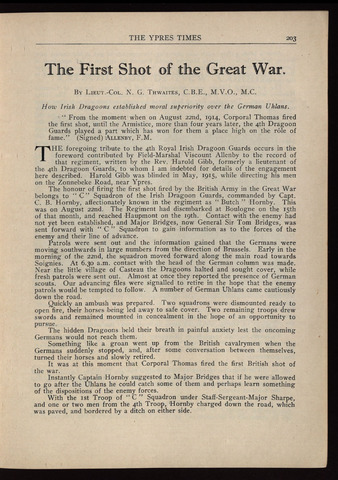By Lieut.-Col. N. G. Thwaites, C.B.E., M.V.O., M.C.
THE YPRES TIMES
203
Hoi0 Irish Dragoons established moral superiority over the German Uhlans.
From the moment when on August 22nd, 1914, Corporal Thomas fired
the first shot, until the Armistice, more than four years later, the 4th Dragoon
Guards played a part which has won for them a place high on the róle of
fame." (Signed) Allenby, F.M.
HE foregoing tribute to the 4th Royal Irish Dragoon Guards occurs in the
foreword contributed by Field-Marshal Viscount Allenby to the record of
that regiment, written by the Rev. Harold Gibb, formerly a lieutenant of
the 4th Dragoon Guards, to whom I am indebted for details of the engagement
here described. Harold Gibb was blinded in May, 1915, while directing his men
on the Zonnebeke Road, near Ypres.
The honour of firing the first shot fired by the British Army in the Great War
belongs to "C" Squadron of the Irish Dragoon Guards, commanded by Cap.t.
C. B. Hornby, affectionately known in the regiment as Butch Hornby. This
was on August 22nd. The Regiment had disembarked at Boulogne on the 15th
of that month, and reached Haupmont on the 19th. Contact with the enemy had
not yet been established, and Major Bridges, now General Sir Tom Bridges, was
sent forward with C Squadron to gain information as to the forces of the
enemy and their line of advance.
Patrols were sent out and the information gained that the Germans were
moving southwards in large numbers from the direction of Brussels. Early in the
morning of the 22nd, the squadron moved forward along the main road towards
Soignies. At 6.30 a.m. contact with the head of the German column was made.
Near the little village of Casteau the Dragoons halted and sought cover, while
fresh patrols were sent out. Almost at once they reported the presence of German
scouts. Our advancing files were signalled to retire in the hope that the enemy
patrols would be tempted to follow. A number of German Uhlans came cautiously
down the road.
Quickly an ambush was prepared. Two squadrons were dismounted ready to
open fire, their horses being led away to safe cover. Two remaining troops drew
swords and remained mounted in concealment in the hope of an opportunity to
pursue.
The hidden Dragoons held their breath in painful anxiety lest the oncoming
Germans would not reach them.
Something like a groan went up from the British cavalrymen when the
Germans suddenly stopped, and, after some conversation between themselves,
turned their horses and slowly retired.
It was at this moment that Corporal Thomas fired the first British shot of
the war.
Instantly Captain Hornby suggested to Major Bridges that if he were allowed
to go after the Uhlans he could catch some of them and perhaps learn something
of the dispositions of the enemy forces.
With the 1st Troop of C Squadron under Staff-Sergeant-Major Sharpe,
and one or two men from the 4th Troop, Hornby charged down the road, which
was paved, and bordered by a ditch on either side.

